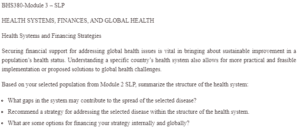Health Systems and Financing Strategies
The African continent is usually the worst hit with Ebola outbreaks. The behavior and culture of the African population have been implicated in the spread of the disease. Practices such as consumption of bushmeat and encroachment into forests can lead to the spread of the disease. This paper identifies the gaps in the African health system that may contribute to spreading the Ebola virus. The report recommends a strategy for addressing the Ebola virus and identifies options for financing the plan.
The structure of the health system in the African continent has some shortcomings that can contribute to the spread of the Ebola virus. The health care system is not well established. This is evident by the lack of proper and adequate infrastructure, healthcare providers, and medications (Azevedo, 2017). Inadequate infrastructure poses a considerable challenge during Ebola virus outbreaks. The limited number of hospitals are overwhelmed by the cases of the virus.
Furthermore, the hospitals lack isolation centers that can be used to quarantine patients (Abayomi et al., 2016). Patients are forced to remain at home. This contributes to the spread of the virus to other healthy community members.
Lack of adequate health education leads to the spread of the disease. Hospitals and the Department of Health are not involved in public campaigns that seek to sensitize people about the condition (Sprecher, 2020). Such educational forums are essential in educating society on preventive measures, the signs and symptoms of the disease, and disease management. Humanity is ignorant due to deficient educational seminars. They are likely to contract and transmit the disease unknowingly.
The ratio of healthcare providers to patients is low. The needs of all patients cannot be addressed during outbreaks. This has necessitated a backup from healthcare workers from other continents during Ebola outbreaks (Cooper et al., 2016). In addition to the shortage of healthcare providers, personal protective equipment is inadequate. This puts the healthcare providers at a high risk of contracting the disease from patients.
The Ebola virus can be managed adequately by a strategy that advocates for health education and improving the healthcare infrastructure of the African continent. This should be prioritized in worst-hit countries such as Sierra Leone, Liberia, Guinea, and Congo-Zaire. The improvement in the infrastructure involves the construction of more hospitals and isolation centers. Furthermore, the upgrade in infrastructure should entail an elaborate procedure of contact tracing and a surveillance system (Greiner et al., 2015). Community health education is critical to preventing the spread of the disease. Healthcare providers and the Department of Health should facilitate health education. Public campaigns and media, such as radio and television, will bring this to fruition.
A collaborative effort between national governments and international foundations will fund the strategy. Federal governments should support health education forums in their countries. They will finance the Department of Health to provide preventive and promotive health education. The national governments and international foundations will finance infrastructure improvement. Examples of prospective international foundations whose funding will be sought include the World Bank, the International Monetary Fund, the World Health Organization, and the USAID (Graham, 2017). Therefore, a collaborative effort between national governments and international organizations will ensure the strategy is fully funded.
Gaps in the healthcare system of the African continent include poor infrastructure, inadequate health education, and inadequate personnel. These shortcomings contribute to the spread of the Ebola virus during outbreaks. A strategy to ensure the improvement of the infrastructure and provision of health education will be used to address the Ebola virus. National governments and international organizations are the prospective source of funds for the system.
References
Abayomi, A., Katz, R., Spence, S., Canton, B., & Gevao, S. M. (2016). Managing dangerous pathogens: challenges in the wake of the recent West African Ebola outbreak. Global Security: Health, Science and Policy, 1(1), 51–57. https://doi.org/10.1080/23779497.2016.1228431
Azevedo, M. J. (2017). Historical Perspectives on the State of Health and Health Systems in Africa, Volume II. In Historical Perspectives on the State of Health and Health Systems in Africa, Volume II: Vol. II. https://doi.org/10.1007/978-3-319-32564-4
Cooper, C., Fisher, D., Gupta, N., MaCauley, R., & Pessoa-Silva, C. L. (2016). Infection prevention and control of the Ebola outbreak in Liberia, 2014-2015: Key challenges and successes. BMC Medicine, 14(1). https://doi.org/10.1186/s12916-015-0548-4
Graham, E. R. (2017). Follow the Money: How Trends in Financing Are Changing Governance at International Organizations. Global Policy, 8(August), 15–25. https://doi.org/10.1111/1758-5899.12450
Greiner, A. L., Angelo, K. M., McCollum, A. M., Mirkovic, K., Arthur, R., & Angulo, F. J. (2015). Addressing contact tracing challenges to halting Ebola virus disease transmission. International Journal of Infectious Diseases, 41, 53–55. https://doi.org/10.1016/j.ijid.2015.10.025
Sprecher, A. (2020). 6 . Challenges in the Management of the West African Ebola Outbreak.
ORDER A PLAGIARISM-FREE PAPER HERE
We’ll write everything from scratch
Question
BHS380-Module 3 – SLP

Health Systems and Financing Strategies
HEALTH SYSTEMS, FINANCES, AND GLOBAL HEALTH
Health Systems and Financing Strategies
Securing financial support for addressing global health issues is vital in bringing about sustainable improvement in a population’s health status. Understanding a specific country’s health system also allows for more practical and feasible implementation or proposed solutions to global health challenges.
Based on your selected population from Module 2 SLP, summarize the structure of the health system:
- What gaps in the system may contribute to the spread of the selected disease?
- Recommend a strategy for addressing the selected disease within the structure of the health system.
- What are some options for financing your strategy internally and globally?

